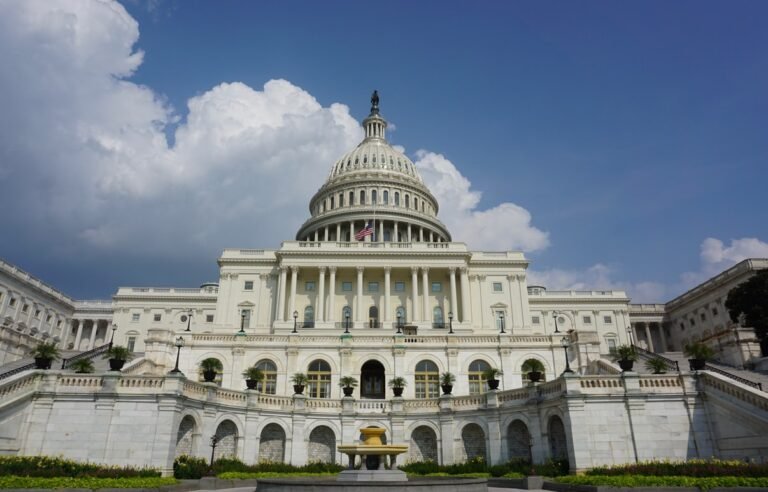Earlier this year, legislative power and unexplained phenomena collided when U.S. Senators Charles Schumer and Mike Rounds introduced the “Unidentified Anomalous Phenomena (UAP) Disclosure Act of 2023.”
Contained within this groundbreaking amendment is a provision concerning “eminent domain,” a government legal tool that is often associated with infrastructure and public interest. However, in the context of UAP, a look at the implications, ethical challenges, and legal complexities tied to applying eminent domain to technology of unknown origin and biological evidence of non-human intelligence (NHI) is warranted.
The UAP Act of 2023’s Eminent Domain clause has already sparked some debate amongst those with legal backgrounds that follow the subject. The current drafted legislation would allow the U.S. government to seize NHI technology and biological evidence. While it appears to grant access to undisclosed NHI discoveries for public benefit, the provision’s reach is broad, and will impact not only major defense contractors but also individuals, private corporations, and other entities involved in scientific explorations.
The challenge of appraising NHI technology for fair compensation and its potential disruption to national defense initiatives further complicates the matter.
What follows is an argument that introduces an alternative regulatory approach, which will help to promote compliance and transparency while preserving property rights and national security interests. The regulatory approach to the subject is a proper first step to safeguarding the balance between public interest and individual freedoms.
Background
In July 2023, a groundbreaking 64-page amendment to the 2024 National Defense Authorization Act was introduced, aptly named the “Unidentified Anomalous Phenomena (UAP) Disclosure Act of 2023.”
Nestled within this extensive framework of legislation lay a specific and contentious provision, “Exercise of Eminent Domain.” This clause, buried on page 57 of the Act, generated a degree of excitement among UFO enthusiasts; in equal measure, it garnered apprehension among those who are well-versed in the complexities of property rights, government authority, and the delicate balance between public interest, corporate entities, and individual freedoms.
Fundamentally, the legislation proposed that the U.S. government could wield its eminent domain powers to seize non-human technology and biological evidence of unknown origin in the name of the public good.
What is Eminent Domain?
The Taking Clause in the Fifth Amendment of the U.S. Constitution states that the government may not take private property for public use without providing fair compensation to the property owner.
However, eminent domain is the legal power through which the government may acquire said private property, provided they satisfy the public use, and just compensation requirements. This power is typically exercised for infrastructure projects like roads, bridges, and public buildings, as well as for urban development or redevelopment.
Public Use: In order to satisfy the public use requirement of eminent domain, the U.S. Government must show that the seizure of property will increase the general public welfare. The interpretation of public welfare has been interpreted in various ways. In 2005, The Supreme Court affirmed the Connecticut ruling, which allowed a government taking of private property that ultimately facilitated a private development (Kelo v. City of New London, 545 U.S. 469 (2005)). Meaning, the government could take the property from one entity and then allow another to utilize it for their own financial gain so long as there is a benefit to the public general welfare.
Just Compensation: Just compensation is normally determined by an appraisal of the property’s value and through negotiations with the owner. If an agreement can’t be reached, the government may proceed with formal court proceedings to obtain a court-ordered taking. The Court will have to determine the fair compensation to the property owner from appraisals provided by the litigants and their expert witnesses. This process balances the public’s needs with individual property rights, aiming to ensure a fair and just outcome for all parties involved.
Major Issues with Eminent Domain Language in UAP Disclosure Act 2023
The relevant language that appears in the current version of the UAP Amendment in question reads as follows:
SEC.__10. DISCLOSURE OF RECOVERED TECHNOLOGIES OF UNKNOWN ORIGIN AND BIOLOGICAL EVIDENCE OF NON-HUMAN INTELLIGENCE.
(a) Exercise of Eminent Domain.– The Federal Government shall exercise eminent domain over any and all recovered technologies of unknown origin and biological evidence of non-human intelligence that may be controlled by private or entities in the interest of the public good.
1) Seizure of Privately Held Property, by the Government, for “Public Use”: While some may applaud the federal government’s potential seizure of Non-Human Intelligence (NHI) technology and biological evidence from private entities as a positive step, there are significant unaddressed concerns.
It is important to note that many in the UFO community might envision major defense contractors willingly surrendering their well-guarded secrets. However, the eminent domain language, as drafted, extends far beyond this scenario. In reality, this provision obligates individuals, such as prominent figures like Jacques Vallee, to relinquish materials in their possession.
Moreover, even private corporations engaged in space exploration or universities conducting research in remote locations, like dragging a magnetic sled on the ocean floor, will be required to surrender any evidence of NHI, making it the property of the U.S. Government, which will then be made available to the “Review Board.”
2) How do you Appraise NHI Technology and Biological Material to satisfy “Just Compensation”? Determining just compensation of NHI technology presents a unique set of challenges. Appraising the value of NHI technology will be exceptionally complex due to the unknown origin and potentially unprecedented characteristics. This same complexity could lead to lengthy negotiations and drawn out legal disputes. Engaging in litigation, with the added intricacies of NHI technology, will only serve to prolong the process, which can already take years until there is a final ruling.
3) What are National Defense Implications with Eminent Domain of NHI Technology? The exercise of eminent domain carries several critical national defense implications. The compulsory relinquishment of Non-Human Intelligence (NHI) technology and biological materials could disrupt the ongoing advancements and initiatives of individual property owners. This disruption may not only erode the value of corporations involved but also potentially trigger a cascade of legal disputes. A thriving and lucrative private sector within the national defense domain has played a pivotal role in supporting U.S. foreign policy endeavors and its capacity to exert influence globally. Moreover, transferring such properties from private entities to the federal government could expose these critical technologies to the risk of foreign intelligence collection, posing security concerns.
Regulation of NHI Material v. Eminent Domain of NHI
Where eminent domain involves the government taking ownership of NHI property, regulation involves the government imposing rules and restrictions on how NHI property owners use their property without taking ownership. The adoption of a regulated NHI policy offers distinct advantages.
First, regulation ensures a smoother transition to government involvement with NHI technology and biological evidence. A regulated industry without government seizures permits corporate entities and private individuals to maintain their constitutionally protected property rights over NHI technology. In this scenario, the property owners can adjust current practices to be in compliance with government laws and maintain potential lucrative technological or scientific breakthroughs.
By complying with the new disclosure requirements to the All-Domain Anomaly Resolution Office (AARO), with additional added language that requires an unclassified publicly available registration, the government will protect national security while promoting transparency and cooperation.
This proposed approach avoids the contentious issue of property seizures and the complexities of determining fair compensation, preserving the delicate balance between public interest and individual rights.
How do we regulate technology of unknown origin and biological evidence? The same way we regulate every other industry that falls under the purview of the U.S. Government, by drafting legislation that requires the disclosure and registration of the property to a proper authority. In the drafted UAP Disclosure Act of 2023, the initial proper authority can be AARO.
Example of Regulation Language for UAP Disclosure Act 2023
By inserting language into the act that regulates NHI materials, the above stated issues and lengthy litigation may be avoided. A sample of regulation language that could be inserted to accomplish the overall goal of disclosure is as follows:
Section “(a) Exercise of Eminent Domain.” shall be deleted in its entirety and replaced with the following:
-
- DISCLOSURE OF NON-HUMAN INTELLIGENCE – Any entity, organization, or individual that has in its possession now or in the past, discovers, or becomes aware of, technologies of unknown origin and/or biological evidence of non-human intelligence, within the territorial boundaries of the United States or under its jurisdiction, shall immediately disclose and register such technology or materials to the All-Domain Anomaly Resolution Office.
- The entity, organization, or individual disclosing the non-human intelligence technology and/or biological materials to the All-Domain Anomaly Resolution Office shall make their disclosure at the derivative classification level of which the materials are held and/or information was collected.
- The All-Domain Anomaly Resolution Office shall disclose the same to the appropriate Congressional committee at the appropriate classification level within 24 hours.
- An unclassified disclosure of technology of unknown origin and/or biological evidence of non-human intelligence shall be written and released to the public within 30 days of the disclosure to the All-Domain Anomaly Resolution Office.
- The unclassified disclosure shall contain the entity, organization, or individual owner’s name, quantity, and a brief description of the property.
- DISCLOSURE OF NON-HUMAN INTELLIGENCE – Any entity, organization, or individual that has in its possession now or in the past, discovers, or becomes aware of, technologies of unknown origin and/or biological evidence of non-human intelligence, within the territorial boundaries of the United States or under its jurisdiction, shall immediately disclose and register such technology or materials to the All-Domain Anomaly Resolution Office.
-
- EXERCISE OF EMINENT DOMAIN – The Federal Government shall exercise eminent domain over any and all recovered technologies of unknown origin and biological evidence of non-human intelligence that may be controlled by private persons or entities that fail to disclose the same to the All-Domain Anomaly Resolution Office, in the interests of the public good.
Summary
Here, we have explored several of the ethical, legal, and practical challenges that may be associated with the current language that appears in the Unidentified Anomalous Phenomena (UAP) Disclosure Act of 2023.
In addition to the concerns highlighted here, which include the seizure of privately held property, the appraisal of NHI technology, and national security implications, we propose the U.S. Government take an alternative regulatory approach to the subject.
By regulating the property in question, the government may avoid the above stated issues and promote stakeholder compliance, government transparency, and the protection of property rights, which, we feel, will also preserve the balance between public interest and individual freedoms.
Sean Munger is an attorney practicing law in Massachusetts and a Suffolk University Law School graduate. Munger also served as an intelligence analyst with the United States Marine Corps, and served with its Warfighting Laboratory and the 26th Marine Expeditionary Unit. He can be reached at sean@thedebrief.org.

